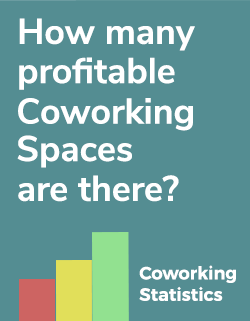Not surprisingly, the most important criteria to win new coworkers is a low entry price. It should be well below the cost of a traditional furnished office. Price is followed by location, flexible lease terms, good basic amenities and a pleasant working atmosphere; and for the last, regular coworkers like to be able to contribute to shaping their own working environment.
The location
For reasons of accessibility, many coworking spaces chose locations that are well connected to buses or trains, mostly in downtown districts that are hip but still reasonable cheap – just close to where their target group lives. To keep rents low, very few of them are located directly on the street behind a large shop window. More often, you pass through a courtyard or back door, with the working space found on the upper levels of an older office or factory building. Where urban development is focused on automobile and homeowners, like in the U.S., many coworking spaces are also found in suburbs, on ground level, with lots of parking.
But wherever you plan a business, the first steps of potential customers to your coworking space are less inhibited the more a part of your space is oriented toward the street. An open access or an interconnecting cafe area makes it much easier for them to get a quick overview of the location than behind closed doors on the 4th.
Once a suitable place is found, the longer contract negotiations can begin. The rules of supply and demand will help determine the price. Beside a security deposit, the owner is also interested in seeing a firm, sustainable business concept. Start-up coworking space operators often run into opposition from real estate agents or property owners, who are, after all, potential competitors in this market. Real estate agents want to know – how can you do our job better than us?
If you open a cospace in a country, which supports high offices prices by subsidies and tax reductions, you will face problems in haggling over the price even in areas with an high rate of empty offices. Just small real estate companies offer more flexibility. Otherwise ask for investment boni or start discounts. Such instruments save the market price for owners but nonetheless you can make a good deal.
The equipment
To keep costs low, most coworking spaces start up without an expensive fit-out. Seed capital is normally spent on simple ideas, or even more often on do-it-yourself handiwork.
So the London Cube recycled old wooden boards into new white-painted tables, Betahaus in Berlin uses fiberboards on metal frames, and The Hub in Tel Aviv mounted particleboards on metal pillars. Even kitchen benches or ping-pong tables can be revived as desks in a coworking space.
The technical fit-out is restricted to the bare necessities of an operating office. Expensive telephone switchboards and phones on every table are unnecessary when most coworkers can be reached by mobile phone or over the Internet. Electrical wiring is sometimes left hanging from the ceiling. For preparing coffee, a simple kettle will often suffice.
However, Coworking spaces that offer more than WIFI, a table and a kettle usually are more successful. This depends less on more comfort but on the in-house networking, entertainment and consulting events organized for the members. Holding workshops or collective dinners strengthens the ties and the productive cooperation of the coworkers themselves – and the ties to your coworking space.
The prices
Besides low prices, many popular coworking spaces package their costs together, rather than charging for each individual service. This helps them stand out from the non-transparent pricing polices of many business centers. In some cases, they provide only one monthly price which includes free coffee and a reasonable amount of photocopying. Such a concept works very succesfully for Le Bureau in London.
Because many self-employed people can’t (or don’t want to) commit to being in one location every day, most of coworking spaces offer several packages which vary in length and access ability. Full packages may include a fixed desk and around-the-clock access. Cheaper packages may offer flexible shared desks, with access reduced to certain time periods. Desks are let on a monthly, weekly or daily basis.
Like most businesses, coworking spaces prefer long-term customers, but the majority offer packages that allow a contract to be terminated with a month’s notice. Many customers live on short-term projects and don’t know yet what will be in three months time.
The layout
Here coworking spaces vary greatly depending on whether they appeal to a broad or specific target group. The philosophy of the spaces also comes into play. Avoid oversized rooms and refrain from installing elements that separate the space, if you want to promote interaction between the customers. Some coworking spaces provide a mixture of interactive and private areas, depending on the mood and requirements of the users, who may wish to work in groups or alone.
Specialist studios such as Paragraph in New York, which is open only to writers, intentionally prevent eye contact between cubicles. For them, undisturbed writing is essential to a good working atmosphere. Collective discussions are only to be held in break areas. Consider from the beginning which target group you wish to concentrate on, as not all work well alongside each other.
The name
In the era of search engine optimization, many start-ups base their name on the service and product they offer. For coworking spaces it’s no different. So far, three types of names have been established.
The most obvious but also most boring variety is that which combines the word „coworking“ with the city name. Such a combination may be suitable as subtitle or a working title for a start-up project. But it doesn’t have any recognition factor and may be contested by others entering the market - even if just as subtitle. Such a generic name may be hard to market, but will be good for search engine results.
The second type of name opts for word combinations that refer to a place with a new outlook on the concept of work, without having to be too idealistic. Examples include IndyHall, Citizen Space, The Hive or Betahouse. They often opened their place before knowing the term ‘Coworking Space’. However, such names also can be memorable and explain a new work ethic, and they can be easier to protect when more and more of those spaces will enter the market. But interestingly, even some bigger chains fail to take steps to properly protect their trademarks. So it doesn’t seem to be a topic with high priority yet.
The third type of name includes elements of the street name, house number, or history of the building or area. Some advice is to keep it simple, catchy, related to the concept of the coworking space, and something not being used by twenty other similar locations.
The beginning
The biggest mistake is to expect customers to flood in once the door is opened. “Opening a space is rarely the first step to creating a coworking space. Building a community is. Much of our success comes from the decisions that stem from that”, Alex Hillmann of IndyHall advises.
If building a community takes too long, then it helps if the opening is coupled with an event that focuses on the target market. That’s what The Cube in London did by partnering with the London Design Week, offering the premises as an event and exhibition location. It’s helpful to host workshops and meetings for industries that contain many freelance workers.
Public relations plays a bigger part, therefore it’s important to exploit this as early as possible – the more spaces, the more interest from the media will decrease. As one of the first coworking space in your country, you should be able to generate big articles in newspapers. As the first in your city, you can expect a few mentions in the local press. As time goes on, new coworking spaces will have to be more savvy and original, and not only rely on continually declaring the death of the traditional office. Despite of all predictions even many journalists still work in one.
The job profile
The most obvious and most important piece of advice comes from coworking spaces which have failed. A coworking space shouldn’t be run as a side-project, but as a full-time business with one or two permanent workers – or with a large group, if they can manage a business without internal conflict.
However, many coworking space owner work in more than one job. If this is your case, make sure, the coworking space fits your job profile like a web company owner which can attract more coworkers of their business and can care for their needs.
Without a knowledge of the requirements of the target market or regular contact with the customers, it’s impossible to keep a coworking space running.
:::::
Related article:












